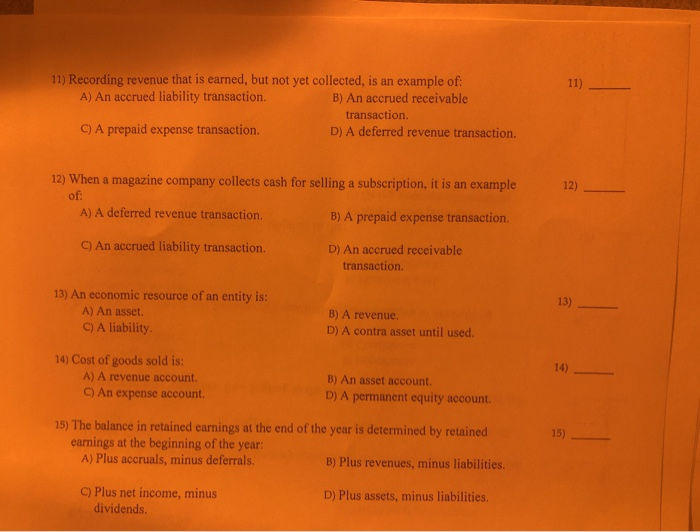



11) - 11) Recording revenue that is earned, but not yet collected, is an example of: A) An accrued liability transaction. B) An accrued receivable transaction. C) A prepaid expense transaction. D) A deferred revenue transaction. 12) When a magazine company collects cash for selling a subscription, it is an example 12) A) A deferred revenue transaction. B) A prepaid expense transaction. C) An accrued liability transaction. D) An accrued receivable transaction 13) 13) An economic resource of an entity is: A) An asset C) A liability B) A revenue. D) A contra asset until used. 14) Cost of goods sold is: A) A revenue account. C) An expense account. B) An asset account. D) A permanent equity account. 15) The balance in retained earnings at the end of the year is determined by retained earnings at the beginning of the year: A) Plus accruals, minus deferrals. B) Plus revenues, minus liabilities. C) Plus net income, minus dividends. D) Plus assets, minus liabilities. dividends. 16) 16) In its first year of operations Best Corp, had income before tax of $500,000. Best made income tax payments totaling $210,000 during the year and has an income tax rate of 40%. What was Best's net income for the year? A) $306,000. B) $290,000. C) $294,000 D) $300,000 17) 17) Permanent accounts would not include: A) Salaries and wages payable. C) Deferred revenues. B) Prepaid rent. D) Interest expense. 18) 18) The purpose of closing entries is to transfer: A) Assets and liabilities when operations are discontinued. B) Accounts receivable to retained earnings when an account is fully paid. C) Inventory to cost of goods sold when merchandise is sold. D) Balances in temporary accounts to a permanent account. 19 19) The balance sheet reports: A) Cash flows for a period of time. B) Assets and liabilities for a period of time. C) Net income at a point in time. D) Assets and equities at a point in time. 20) Red Onion Restaurant would classify a six-month prepaid insurance policy as: A) Investment B) Property, plant, and equipment. C) Goodwill D) Current asset 20) 21) An asset that is generally not expected to be converted to cash or consumed within one year or the operating cycle is: A) Building. B) Supplies C) Inventory D) Accounts receivable. ne they are 22) Which is a shareholders' equity account in the balance sheet? A) Accumulated depreciation. B) Salaries payable. C) Accounts receivable. D) Paid-in capital 23) Rent collected in advance is: A) A shareholders' equity account in the balance sheet. B) An asset account in the balance sheet C) A temporary account, not in the balance sheet at all. D) A liability account in the balance sheet. 24) Notes payable that are due in two years are: A) Current liabilities C) Long-term intangible assets. B) Long-term investments. D) Long-term liabilities. 25) Which of the following is never a current liability account? A) Subscriptions collected in advance from customers. B) Prepaid rent C) Dividends payable. D) Accrued payroll 26) Long-term assets generally include: A) Accounts receivable. B) Land held for a possible future plant site. C) Inventory held for sale. D) Prepaid rent. 27) Assets do not include: A) Property, plant, and equipment Investments. 27 B) Paid-in capital. D) Unexpired insurance. DI UNICA Prvu A) C) Investments 28) 28) Cash equivalents would not include: A) Money market funds. B) Bank drafts. C) Cash not available for current operations. D) U.S. treasury bills. Per 29) The usual difference between accounts payable and notes payable is: A) Known payment terms. B) Explicitly stated interest. C) Current-noncurrent classification. D) Legally enforceable debt. 30) 30) Which of the following is not a required disclosure for related-party transactions? A) The nature of the relationship. B) The amounts due from or to related parties. C) The impact of the transactions on current year's income. D) A description of the transactions. 31) 31) Disclosure notes would not include: A) Definition of cash equivalents. B) Data to adjust the financial statements so that they are not misleading. Details of pension plans. D) Depreciation methods used and estimated useful life. 32) An exception that is so serious that even a qualified opinion is not justified would result in: 32) A) A disclaimer An adverse opinion. B) A consistency exception. D) An unqualified opinion










